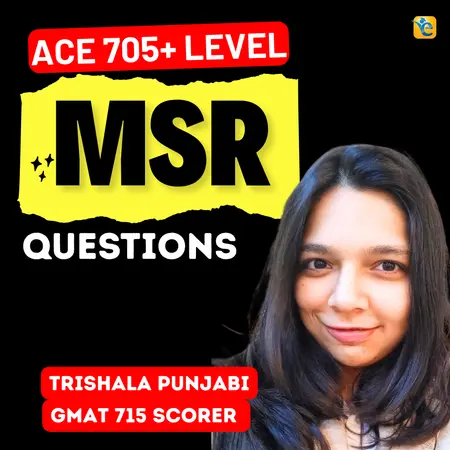Events & Promotions
|
|

GMAT Club Daily Prep
Thank you for using the timer - this advanced tool can estimate your performance and suggest more practice questions. We have subscribed you to Daily Prep Questions via email.
Customized
for You
Track
Your Progress
Practice
Pays
Not interested in getting valuable practice questions and articles delivered to your email? No problem, unsubscribe here.
- Nov 18
11:00 AM PST
-12:00 PM PST
Join us in a live GMAT practice session and solve 30 challenging GMAT questions with other test takers in timed conditions, covering GMAT Quant, Data Sufficiency, Data Insights, Reading Comprehension, and Critical Reasoning questions. - Nov 22
11:00 AM IST
-01:00 PM IST
Do RC/MSR passages scare you? e-GMAT is conducting a masterclass to help you learn – Learn effective reading strategies Tackle difficult RC & MSR with confidence Excel in timed test environment - Nov 23
11:00 AM IST
-01:00 PM IST
Attend this free GMAT Algebra Webinar and learn how to master the most challenging Inequalities and Absolute Value problems with ease. - Nov 25
10:00 AM EST
-11:00 AM EST
Prefer video-based learning? The Target Test Prep OnDemand course is a one-of-a-kind video masterclass featuring 400 hours of lecture-style teaching by Scott Woodbury-Stewart, founder of Target Test Prep and one of the most accomplished GMAT instructors.
Kudos
Bookmarks
I don't see a difference between your intermediate conclusions and the main conclusion, except that the main conclusions states both at once. It's a somewhat unusual structure, because there are 2 parts to the conclusion, call them 'A and B.' Then the author says 'A is true because...' and then 'B is true because...'
("A" = 'painting completed after 1507,' "B" = 'painting completed before 1509.')
If we label the entire statements: "A because PremA" and "B because PremB" as PREMISES that had to be true, then there is no doubt that the conclusion "A and B" are true. So we have to be able to doubt "A because PremA" and/or "B because PremB." But we DON'T want to doubt PremA and PremB.
("A" = 'painting completed after 1507,' "B" = 'painting completed before 1509.')
If we label the entire statements: "A because PremA" and "B because PremB" as PREMISES that had to be true, then there is no doubt that the conclusion "A and B" are true. So we have to be able to doubt "A because PremA" and/or "B because PremB." But we DON'T want to doubt PremA and PremB.
ReedArnoldMPREP
But there is a gap, though subtle, between the 'intermediate conclusion' and the 'main conclusion'. It's a 'fences and posts' issue, one encounters in counting, and actually that gap was what threw me off
The 'intermediate conclusion' "It cannot have been painted after 1509..." allows for the possibility of the painting being completed in 1509; Whereas, the main conclusion "..but before 1509" does not allow for that possibility.
Kudos
Bookmarks
Braintree
Ahhhh, I see. Yeah, again wish they'd been more clear on that. "before the end of 1509" and "before the beginning of 1507" would have been clearer. So you might have been wondering, "If he started at the very beginning of 1507, and finished at the very end of 1509, that is prettttty dang close to 'several years' and the argument still stands."
I guess 2.9 years just doesn't QUITE count as 'several.'









